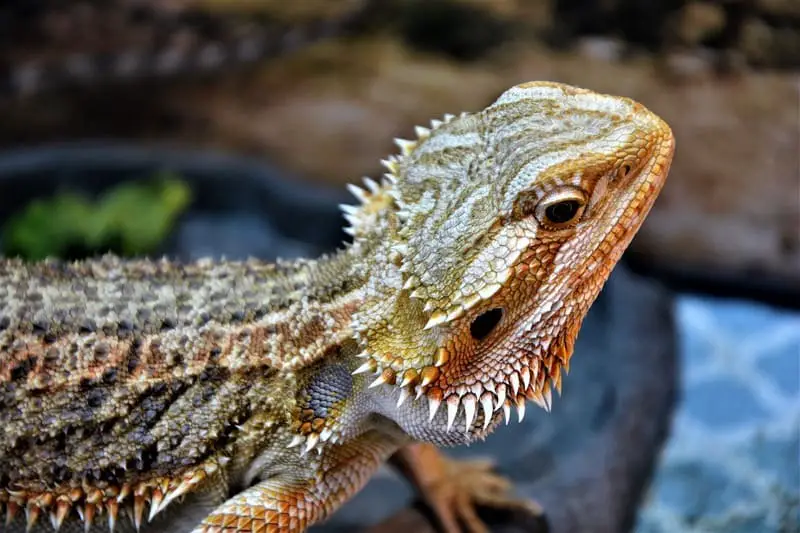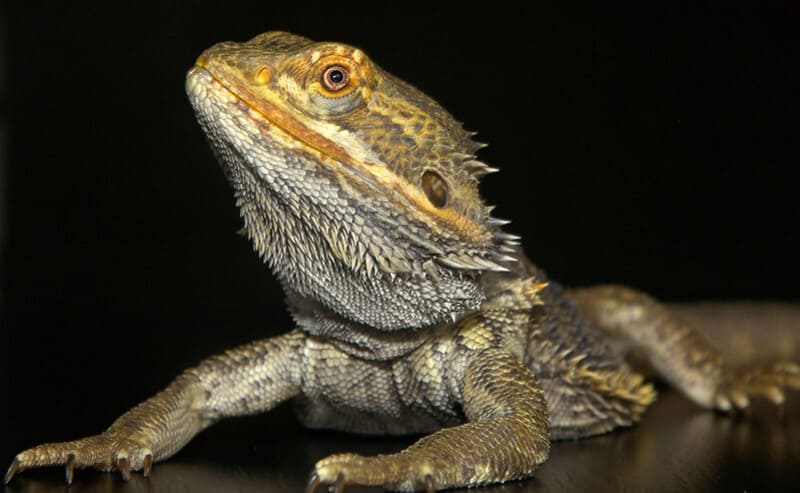Are bearded dragons smart? This topic delves into the intriguing world of bearded dragon intelligence, exploring their cognitive capabilities, problem-solving skills, social behaviors, and how they interact with their environment.

The Intelligence of Bearded Dragons
Intelligence in animals varies across species, and what constitutes intelligence can differ from one organism to another. When assessing the intelligence of bearded dragons, we must consider their specific behaviors and adaptations in the context of their environment.
Bearded dragons exhibit certain cognitive abilities that showcase their adaptability to their surroundings. While they may not have the same level of intelligence as mammals like dogs or primates, they display specific traits that are indicative of their cognitive capacities:
1. Learning by Association
Bearded dragons have demonstrated the ability to learn by association. For example, they can associate certain cues or stimuli with feeding times or favorable environmental conditions. They learn to recognize their owners and may respond to them in specific ways, such as approaching when they see familiar faces.
2. Problem Solving
Bearded dragons are capable of basic problem-solving. They can figure out how to access food, water, or basking spots within their enclosures. This implies a level of spatial cognition and memory that allows them to navigate and adapt to their surroundings.
3. Environmental Awareness
Bearded dragons display environmental awareness by responding to changes in their surroundings. They are alert to temperature variations, lighting conditions, and other environmental cues. This awareness helps them adapt to their environment and make necessary behavioral adjustments.
4. Social Cognition
While bearded dragons are not social animals by nature, they do display a degree of social cognition. They can recognize other bearded dragons and perceive the dominance hierarchy within a group. Their social behaviors, such as head bobbing and arm waving, are indicative of their ability to communicate and respond to conspecifics (members of the same species).
5. Navigation
Bearded dragons are skilled navigators within their natural habitats. They can remember the locations of essential resources like food, water, and basking sites. This navigational ability reflects a level of spatial intelligence.
6. Memory
Bearded dragons have shown evidence of memory retention. They can remember where food sources are located and may recall feeding schedules, which is particularly relevant for their survival in the wild.
Problem-Solving Abilities
Bearded dragons possess problem-solving skills that enable them to adapt to their environment and secure essential resources. Some examples of their problem-solving abilities include:
1. Accessing Food
Bearded dragons are known for their keen sense of vision and the ability to spot prey. In captivity, they must problem-solve to catch and consume moving insects. Their hunting behavior includes stalking and lunging at prey items, demonstrating a degree of strategic thinking.
2. Navigating Enclosures
In captive environments, bearded dragons often have access to complex enclosures with various structures, hiding spots, and basking areas. They can navigate these environments efficiently, demonstrating their ability to problem-solve and find the ideal conditions for thermoregulation and security.
3. Recognizing Owners
Bearded dragons can recognize and remember their owners. They may display different behaviors when interacting with familiar individuals, such as approaching the owner or displaying head bobbing, which can be interpreted as a form of recognition or social communication.

Social Behavior and Communication
Bearded dragons exhibit intriguing social behaviors that suggest a level of social cognition and communication within their species. These behaviors are not only essential for survival but also provide insights into their level of intelligence. Some key social behaviors and communication methods include:
1. Head Bobbing
One of the most recognizable social behaviors of bearded dragons is head bobbing. This rhythmic movement of the head up and down or side to side is used in various social contexts. Males may head bob to communicate dominance or territorial claims, while females may head bob in response to males during courtship.
2. Arm Waving
Arm waving is another form of social communication. Bearded dragons may extend one of their forelimbs and wave it gently, particularly during interactions with other bearded dragons. It’s often seen as a submissive or appeasing gesture.
3. Postural Changes
Bearded dragons display different body postures to convey their intentions or emotions. For example, they may flatten their bodies and darken their coloration to appear more substantial and intimidating, or they may puff out their “beard” as a display of aggression or fear.
4. Gaze and Body Orientation
Bearded dragons use their gaze and body orientation to communicate with conspecifics. They may direct their attention toward specific individuals or objects to convey their interest, intention, or alertness.
5. Vocalizations
While not as vocal as some other reptiles, bearded dragons can produce vocalizations, particularly during interactions with potential mates. These vocalizations are low-frequency sounds and vibrations produced in the throat.
Adaptation to the Environment
Bearded dragons are native to the arid and semi-arid regions of Australia, where they have evolved to adapt to a harsh and fluctuating environment. Their ability to survive in these conditions reflects their capacity to adapt and problem-solve. Some aspects of their adaptation to the environment include:
1. Thermoregulation
Bearded dragons are ectothermic, meaning they rely on external sources of heat to regulate their body temperature. They are skilled at finding the optimal temperature zones within their environment to maintain their internal temperature.
2. Feeding and Foraging
In the wild, bearded dragons are opportunistic omnivores. They must adapt to the availability of food sources, which can vary depending on the season and environmental conditions. Their ability to find, capture, and consume food reflects their problem-solving skills.
3. Shelter and Hiding
Bearded dragons seek shelter and hiding spots to protect themselves from predators and extreme weather conditions. Their capacity to locate and use these hiding spots is indicative of their cognitive abilities.

Individual Variability
It’s important to note that, like other animals, individual variability exists among bearded dragons. Some individuals may exhibit more pronounced problem-solving skills, social behaviors, or environmental adaptations than others. Factors that can influence these differences include genetics, early experiences, and social interactions.
Limitations in Bearded Dragon Intelligence
While bearded dragons demonstrate a range of cognitive abilities, it’s essential to recognize their limitations compared to more complexly evolved animals like mammals. Some limitations in bearded dragon intelligence include:
1. Lack of Complex Learning
Bearded dragons do not engage in complex learning or problem-solving tasks to the extent that some mammals do. While they can learn by association and adapt to their environment, their problem-solving skills are generally limited to tasks related to survival, navigation, and social interactions.
2. Limited Social Behavior
Bearded dragons are not highly social animals and do not engage in complex social structures or cooperative behaviors. Their social behaviors are primarily focused on dominance and reproductive interactions.
3. Instinctual Behavior
Much of bearded dragons’ behavior is driven by instinct and natural responses to environmental cues. Their problem-solving abilities are adapted to their specific ecological niche and are not geared toward more abstract or complex tasks.
4. Limited Vocalizations
Bearded dragons are not known for extensive vocalizations or communication. Their vocal repertoire is relatively simple compared to mammals with more developed vocal communication.
5. Minimal Tool Use
While some animals exhibit tool use and manipulation, bearded dragons do not display this behavior. Their problem-solving is typically limited to their immediate environment and available resources.
The Influence of Environment and Enrichment
The intelligence and cognitive abilities of bearded dragons can be influenced by their environment and the level of enrichment provided. Enrichment activities, such as introducing novel objects, hiding spots, and opportunities for exploration, can stimulate their cognitive and problem-solving skills.
Owners can enhance the cognitive development of their bearded dragons through enrichment by providing:
1. Novel Objects
Introduce safe, non-toxic objects into their enclosure for exploration. Novel objects can pique their curiosity and engage their problem-solving abilities.
2. Climbing Structures
Bearded dragons enjoy climbing, and providing safe branches or structures within their enclosure can encourage this natural behavior. Climbing activities stimulate their problem-solving and motor skills.
3. Digging Opportunities
Create designated areas within their enclosure for digging. Bearded dragons may enjoy burrowing and excavating, which can be both stimulating and enriching.
4. Feeding Challenges
Hide food items or insects within their enclosure to encourage them to search and hunt for their meals. This can simulate natural foraging behavior and enhance their problem-solving skills.
5. Social Interaction
While bearded dragons are not highly social, controlled interactions with conspecifics can provide them with opportunities for social cognition. Care should be taken to ensure the interactions are stress-free and safe.
Individual and Species Variation
It’s important to recognize that individual variation exists within the bearded dragon species. Some bearded dragons may demonstrate more pronounced problem-solving abilities, social behaviors, or environmental adaptability compared to others. Factors contributing to individual variation may include genetics, early experiences, and interactions with their environment and caregivers.
Owners may observe unique cognitive traits or behaviors in their individual bearded dragons. However, it’s essential to appreciate that these differences fall within the broader spectrum of cognitive abilities exhibited by the species.
Practical Implications for Bearded Dragon Care
Understanding the cognitive abilities and limitations of bearded dragons has practical implications for their care. Here are some key considerations for bearded dragon owners:
1. Enrichment
Providing enrichment activities within the enclosure is essential to stimulate their cognitive abilities. This can include introducing novel objects, climbing structures, hiding spots, and opportunities for foraging and digging.
2. Problem-Solving
Consider the reptile’s natural behaviors and problem-solving skills when setting up their environment. Bearded dragons benefit from access to basking spots, hiding spots, and a variety of substrate materials for digging.
3. Social Interaction
While bearded dragons are not highly social, controlled interactions with conspecifics can provide opportunities for social cognition. Owners should be attentive to the stress levels and comfort of their pets during such interactions.
4. Recognizing Owners
Bearded dragons can recognize their owners and respond to them. Positive interactions with the owner can help build trust and a positive association with their presence.
5. Monitoring Health
Understanding the cognitive limitations of bearded dragons is important for recognizing potential health issues. Owners should monitor their pet’s behavior and appearance for signs of illness or distress.
Conclusion
Bearded dragons, with their unique behaviors and cognitive abilities, represent an intriguing aspect of the reptile world. While they may not display the same level of intelligence as more complexly evolved animals like mammals, their problem-solving skills, social behaviors, and adaptability to their environment reflect a fascinating level of cognition.
Owners can enhance the cognitive development of their bearded dragons by providing enrichment and opportunities for problem-solving. Understanding the species’ cognitive abilities and limitations is essential for their well-being and care. Ultimately, bearded dragons are a remarkable example of the diverse and fascinating world of reptiles.
